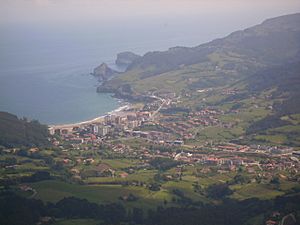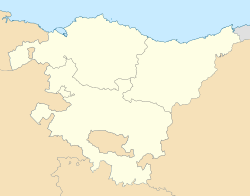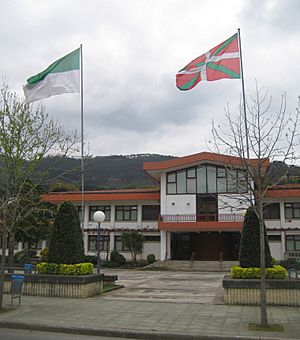Bakio facts for kids
Quick facts for kids
Bakio
Baquio
|
|||
|---|---|---|---|

Aerial view of Bakio
|
|||
|
|||
| Country | |||
| Autonomous community | |||
| Province | Biscay | ||
| Comarca | Mungialdea | ||
| Founded | Unknown | ||
| Area | |||
| • Land | 16.78 km2 (6.47 sq mi) | ||
| Elevation | 7 m (23 ft) | ||
| Population
(2018)
|
|||
| • Total | 2,645 | ||
| • Density | 151.49/km2 (392.90/sq mi) | ||
| Demonym(s) | Bakiotarra | ||
| Time zone | UTC+1 (CET) | ||
| • Summer (DST) | UTC+2 (CEST) | ||
| Area code(s) | 48 | ||
| Official language(s) | Basque and Spanish | ||
Bakio (also called Baquio in Spanish) is a small town in the Basque Country, a region in northern Spain. It's located in the province of Biscay.
Contents
About Bakio
Bakio is in a small valley with the Estepona River flowing through it. Mountains surround the valley on three sides, but it opens up to the Cantabrian Sea in the north. The town is right next to the sea.
It shares borders with the town of Bermeo to the east, Mungia to the south, and Maruri-Jatabe and Lemoiz to the west. Bakio is well connected to Bilbao, the capital city of the region, by regular bus services.
The town was once known as Básigo de Baquio. This was the name of its main neighborhood. In 1927, two neighborhoods that belonged to Bermeo, San Pelayo and Zubiaur, became part of Bakio.
Even though Bakio is on the coast and used to be a fishing village, it doesn't have a strong fishing tradition anymore. Instead, it became more of a farming town. Recently, many new apartment buildings have been built, changing the look of the town.
Bakio has a special climate. It gets a lot of rain and stays warm, with almost no snow or frost. This climate is great for growing grapevines and making a special local wine called Txacoli.
Local Government
In the 2015 local elections, different political parties won seats on the town council:
- EAJ-PNV: 5 councillors
- Bildu: 4 councillors
- BakioBai: 2 councillors
Councillors are like elected representatives who help make decisions for the town.
Buildings and History
Bakio's buildings have a unique style, typical of northern Spain.
Churches and Chapels
The main church is the Parish Church of Andra Mari. It was built in the 16th century in the Gothic style and is in the Básigo neighborhood. There are also several smaller chapels in the countryside, like St. Martin, Saint Úrsula, St. Esteban, St. Cristóbal, and Saint Catalina. These chapels have a simpler, traditional style.
Old Houses and Mansions
Bakio has many interesting old buildings from the 17th century onwards. You can learn about them by following special paths marked by the Town Council.
During the Baroque Period, important families built grand houses like Elexpuru and Ormatza. These were large country homes that showed how wealthy and important the families were.
In the early 1900s, new types of buildings appeared. Wealthy people from Bilbao started building holiday mansions along the road between the church and the sea. These houses had many different styles. They were built to show off the owners' money and social status.
Some of the oldest mansions, like Feliena and Quintatorre (built in 1896), looked like French buildings. Others, built a bit later, were inspired by older Baroque styles, such as the Itxas-Ondo Palace from 1930. Later, other styles were used, like Rosario Enea (neo-Cantabrian style) and Loraldia or Isabela (neo-Basque style). Today, you can also see modern single-family houses from the 1960s, like Aretaetxekosolo or Aristondo.
Economy and Farming
For a long time, Bakio's main ways of making money were farming and raising animals. Fishing was less important. The heart of the old economy was the "caserío" (or baserri), which is a traditional farmhouse where families lived and kept their livestock.
You can still see many different types of farmhouses in Bakio. Some have a special porch with wooden beams (like Gorrondona and Artetxe), some have an arched porch (like Bidetxe), and others have a simple, cube-like shape (like Gabantxo).
Even today, agriculture is very important in Bakio. Farmers grow high-quality traditional products, especially the famous "txakoli" wine. Many buildings in Bakio still have structures that show how grapes were traditionally grown on trellises.
Old Mills and Foundries
Mills and foundries are some of the oldest examples of how people used water power in the countryside. In the 18th century, many of these places were built along Bakio's river. There were as many as eight mills and three forges.
Forges were places where iron ore was heated and shaped. The iron ore arrived in Bakio by boats from a nearby area called Encartaciones. Important local families owned these mills and forges, and they would rent them out for many generations.
Some of Bakio's mills were still working until a few decades ago. A few of them still have their old machinery and features. Some have even been turned into restaurants that you can visit today.
Fun Events
During the summer, Bakio organizes many events. These events make vacations more fun and add to the town's cultural life. Some popular events include:
- The Bakio Music Week
- The International Folklore Festival
- Outdoor cinema nights
- The Jai alai Championship (a traditional Basque sport)
- A handicraft market
- A photography contest
- A farmers' market
- Different patron saint's days, like San Pelaio Day (June 6) and "Andra Mari" Day (August 15)
- The Surfing Championship
See also
 In Spanish: Baquio para niños
In Spanish: Baquio para niños







